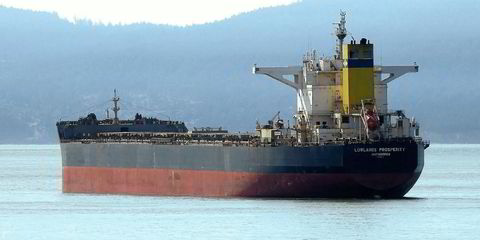What a difference a year makes.
As Omar Nokta gazes out at the public shipowners starting to report earnings for the second quarter, he notes a certain unease and lack of clarity across the landscape compared with the relative optimism of summer 2022.
Jefferies’ lead shipping analyst pointed out the contrast in an interview with Streetwise this week.
“A year ago, containers and tankers were in record earnings territory, while dry bulk, LNG and LPG were reporting historically strong results,” he said.
“I feel that a year ago there was a lot of excitement and a lot of new investor eyes on the sector. It was a different mood and feeling around Marine Money Week in New York this June. It felt a lot more sombre. There were a lot of questions and clearly not as much excitement.”
Now, to be clear, Nokta is not describing an outlook that is overall gloomy — just fraught with uncertainty and fairly difficult to read. Key sectors such as tankers and dry bulk still can speak of newbuilding orderbooks near historic lows, keeping supply in check even if the demand side is less clear.
The LPG sector stands alone as a star performer, but it is a niche market that is not on the radar screen for many investors. Tankers, dry bulk and container ships can all speak of some degree of market weakness, although timing and duration are likely to vary.
Investor reticence is borne out in Jefferies’ numbers on valuations of the 27 stocks under its coverage.
Public companies in the relatively tiny gas sector are trading at an average 89% of net asset value (NAV), and that is the best performance of the shipping operating sectors.
Container liner operators are next at 79% of NAV, with tankers and bulkers averaging 74%. Container ship lessors bring up the rear at 54%.
Even with all the quibbling about using NAV as a valuation metric, the message seems clear: investors actually attach a negative value to the presence of public-company management teams as opposed to buying the steel.
Still, this is not to say there wasn’t some money to be made in shipping stocks in the first half of 2023.
The Jefferies stocks gained an average 1.2%, or 9.7% with dividends factored in. This compares with a 15% gain by the S&P 500 index over the same period.
But returns were higher for certain individual companies, with a tilt towards tankers.
First-half results
Dorian LPG had the highest gain in share price at 35.4%. It was followed by container lessor Danaos (26.8%), Teekay Tankers (24.1%), Nordic American Tankers (NAT, 19.9%) and tanker owner Frontline (19.7%).
Dorian still led the way with dividends factored in, logging a total return of 45.9%. But the runner-up was German liner operator Hapag-Lloyd (40.3%), followed by Frontline (34.3%), NAT (29.7%) and Danaos (29.7%).
The biggest loser in pure share price was Israeli liner company Zim — a 27.9% drop. Other stragglers included liner operator AP Moller-Maersk (down 23.3%), diversified owner Navios Maritime (15.8%), product tanker owner Ardmore Shipping (14.3%) and dry bulk’s Golden Ocean Group (13.1%).
With dividends considered, Navios was the biggest loser at 15.4%. Then came clean product giant Scorpio Tankers (12.2%), Golden Ocean (9.7%), Ardmore (8.7%) and dry bulk’s Genco Shipping & Trading (4.4%).
Of note in the numbers is the effect of the large dividends the big liner operators have still been able to pay despite the soured market.

While Zim lost 27.9%, its total return was 9.3% thanks to dividends. Maersk lost 23.3% but logged a 4.2% return. And while Hapag-Lloyd gained only 4.8%, dividends allowed it to return 40.3%.
The same dynamic allowed the liners to be the worst shares performer with a 15.5% loss on average, yet the biggest returner at 17.9%. Gas led the shares-based return at 12.5% and came second in total return with 17.8%.
Container lessors gained 6.6% in stock price and returned 9.1% with dividends. Tankers gained 3.5% in share price and 11.2% overall. Dry bulk stocks were losers in both categories, at 4.5% in share price and 0.2% with dividends counted.
So what is Nokta watching as quarterly results start to roll in?
A look ahead
Tankers: “I think there will probably be mention of how much firmer this market is despite the headwinds we’ve seen, like the Saudi production cuts. VLCCs have averaged $40,000 a day for the past four months, which is lower than the $50,000 over the previous 12 months, but stabilised at a high level.
“I think we will see seasonal weakness in the third quarter, but then a substantial rise approaching winter amid declining inventories. And as time passes, we can throw away the narrative that this is only happening because of Russia-Ukraine. It’s higher consumption and lower inventories, no room to hide. We may be back to the old tanker market adage: buy in summer, sell in winter.”
Bulkers: “Dry bulk owners are going to be talking about a recovery coming. At least hopefully. Things are soft, but there are prospects for a recovery driven by supply and perhaps some China stimulus.”
Containers: “It is hard to really get a good gauge on containers. Owners feel good about their long-term contract coverage, but they know their customers are losing money. They’re going to be reporting historical results, but somehow it just doesn’t feel like it.”
Gas: “We did a report on Dorian LPG and titled it ‘The gift that keeps on giving’. It really is. It’s a sector that keeps generating so much profit. Yet it’s a niche business and there’s not a lot of investor focus on it.”
More ship finance news
DNB Markets’ Jorgen Lian is adjusting his expectations for a trio of tanker giants ahead of second-quarter earnings. The veteran analyst reiterated buy ratings on DHT Holdings, Euronav and Frontline, but lowered Euronav’s price target. Click here to read.
Watson Farley & Williams and DNB Bank have disclosed their involvement in the $900m restructuring of Dutch shipping group Vroon. Click here to read.
It seems consolidation — or at least the potential it might be happening — is not necessarily so good for shipowners’ performance on environmental, social and governance grounds, as measured by Webber Research & Advisory’s annual ESG scorecard. Click here to read.





